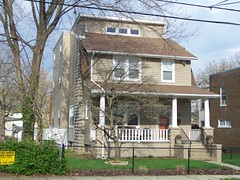Housing Market #3: Historic Preservation

Triple decker with addition and popup, 22nd Street NE, Woodridge.
I am taking an architectural history class this term, and it's a classic example of a little knowledge being overwhelming, because you become particularly conscious of the blending of architectural styles and the difficulty of stating definitively what a particular house "is" because often houses are a mix. (For example, Downing's "Italianate" Houses have a lot of Gothic Revival in them, as this was a transitional period from one dominant style to another.)
The house we're buying has a Craftsman-like interior (my girlfriend disagrees) and I couldn't tell you what it is at all, based on what it looks like outside. It's not a bungalow, and the front facade is definitely changed from what it was originally.
So this has made more more conscious of interiors vs. exteriors. Before I used to care mostly about exteriors.
And it makes me realize that we need to provide resources to people about house preservation in areas that aren't historic districts, but could be or should be, or at the very least, the houses themselves are gems and worthy of saving, or at least, not adulterating.
Historic preservation isn't just about historic districts, it's about great building stock. You know, the nexus of architecture, place, and history.
A couple resources:
-- Historic Chicago Bungalow Initiative (and see "Chicago's Bungalows Making a Comeback" from the Washington Post) and their Design Guidelines
-- Greystone Initiative (Chicago)
-- Rehab Rochester (NY).
Don't look to HGTV for advice. I was looking at an online video that purported to show how a couple updated their bungalow kitchen, while maintaining historic details. What a crock. They destroyed it.
Labels: historic preservation, housing



1 Comments:
thank you very much for the contribution ^
Post a Comment
<< Home